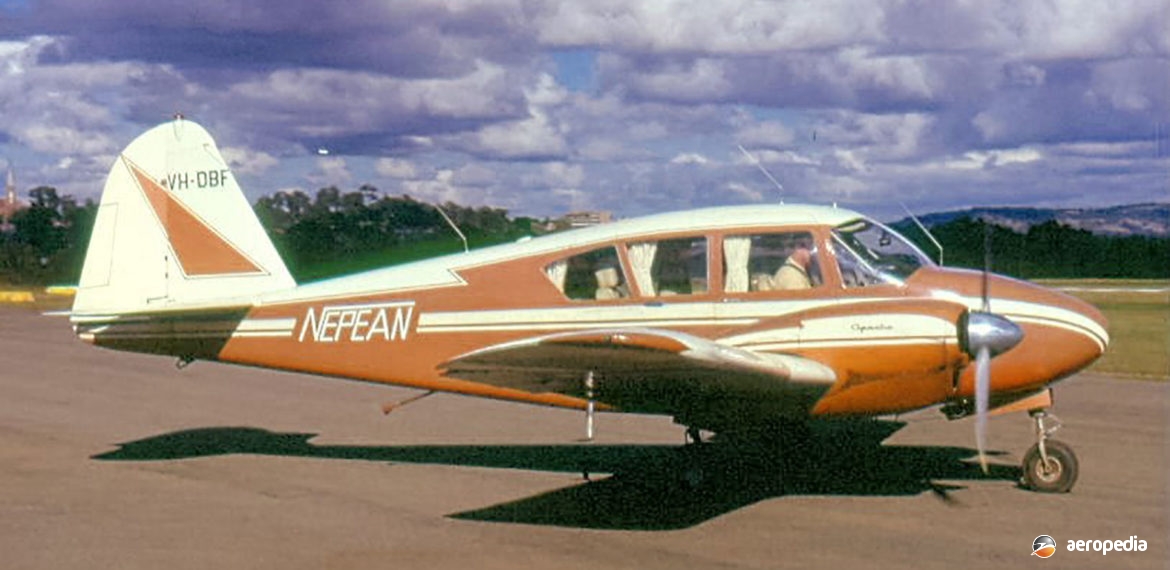Photograph:
Piper PA-23-160 Apache G VH-DBF (c/n 23-1964) at Camden, NSW in June 1974 (David C Eyre)
Country of origin:
United States of America
Description:
Four/five seat light twin-engine cabin monoplane
Power Plant:
Two 112 kw (150 hp) Lycoming O-320-A1A four-cylinder horizontally-opposed air-cooled engines
Specifications:
- Wingspan: 11.28 m (37 ft)
- Length: 8.27 m (27 ft 1½ in)
- Height: 2.9 m (9 ft 6 in)
- Wing area: 18.95 m² (204 sq ft)
- Max speed: 290 km/h (180 mph)
- Cruising speed at 75% power at 1,829 m (6,000 ft): 274 km/h (170 mph)
- Cruising speed at 65% power at 2,743 m (9,000 ft): 261 km/h (162 mph)
- Stalling speed gear and flaps up: 106 km/h (66 mph)
- Stalling speed gear and flaps down: 95 km/h (59 mph)
- Rate of climb at sea level: 411 m/min (1,350 ft/min)
- Service ceiling: 5,639 m (18,500 ft)
- Normal range at 65% power at 2,743 m (9,000 ft): 1,143 km (710 miles)
- Range with max fuel: 1,352 km (840 miles)
- Empty weight: 998 kg (2,200 lb)
- Useful load: 526 kg (1,159 lb)
- Loaded weight: 1,588 kg (3,500 lb)
History:
Known initially as the Piper Twin Stinson, the prototype of the PA-23 Apache series was flown for the first time on 2 March 1952. Piper had acquired rights to the Stinson Voyager in December 1948 and, using the welded steel tube truss of the Twin Stinson, fitted it with twin fins and rudders. Power was provided by two 93 kw (125 hp) Lycoming O-290 engines. It had a retractable undercarriage and seated four. In lieu of being fabric covered it was covered with metal with flush riveting. However, during trials it was found this design failed to meet expectations.
The Twin Stinson was re-designed as the Apache (the first time an aircraft produced by Piper was named after an American Indian tribe) as a low-wing, cantilever monoplane of all-metal construction with Frise-type ailerons and flaps, a single fin and rudder, and was powered by two 112 kw (150 hp) Lycoming O-320 engines driving two-blade Hartzell constant-speed fully feathering propellers. Compared to the earlier design it was lengthened by 1.29 m (4 ft 3 in) and the wingspan was increased by 0.91 m (2 ft 10 in) to 11.28 m (37 ft).
Production deliveries commenced in March 1954. The initial production version, known as the PA-23-150, seating four, was powered by two 112 kw (150 hp) Lycoming O-320-A1A engines. This model was progressively refined, and in 1959 a new version, known as the PA-23-160 Apache F fitted with 119 kw (160 hp) Lycoming O-320-B3B engines, was released.
Further refinement continued, and in 1960 a similar machine appeared, powered by the same O-320-B engines but with extended cabin glazing, and an optional fifth seat. This model became known as the Apache G. At this time, suffix letters were added retrospectively to earlier versions. In 1961 further refinement led to the Apache H, and in August 1962 the first of what would be a major new model appeared, the PA-23-235. This basically had the airframe of the PA-23-250 Aztec but with reduced capacity, and 175 kw (235 hp) Lycoming O-540-B1A5 engines. Seating four with an optional fifth seat, it could be distinguished from earlier Apache models as it had the larger swept tail assembly of the Aztec, and all-moving horizontal tail surfaces, but only 100 examples of this model were completed.
Over the years a number of modifications were made to the series, including windshield wipers, crop-dusting equipment, Rajay turbochargers, and wing-tip fuel tanks. One company in the US re-built Apaches and fitted them with 134 kw (180 hp) Lycoming O-360-A1D engines, a longer nose, square tail, dorsal fin, Horner wing tips etc, calling the aircraft Geronimo.
Production of the PA-23-235 model began in 1963 and continued for a couple of years until eventually production switched to the Aztec. A total of 2,047 Apaches was built. One owned by Norcal Aviation in the US (N34DA – c/n 23-1469) was fitted with Wipline floats.
First of the type seen in this region was imported in January 1957 by Piper Aircraft Australia and it became VH-PKA (c/n 23-689). It was a PA-23-150 and was obtained by Peel River Land & Mineral Co of Tamworth, NSW. It was a Super Custom model, having two additional 68 litre (15 Imp gal) fuel tanks outboard of the main tanks, and a generator on each engine. A small number have been imported over the years but only a few survive. Of the few imported to New Zealand, two, ZK-BYB (c/n 23-1828) and ZK-BLP (c/n 23-1089), operated in the markings of Golden Coast Airways from June 1963 carrying passengers.

